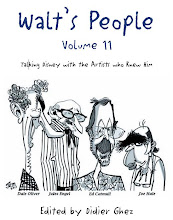
Next month will see the release of Jeff Kurtti's long awaited book Walt Disney's Legends of Imagineering and the Genesis of the Disney Theme Parks. I have asked Jeff to answer a few questions about the book. While it is clear from some of his answers that we approach Disney history from a different angle, I still have tremendous respect for the work he does and his is a book that I will definitely pick up in a few weeks.
Didier Ghez: Why did you decide to work on that book? Can you run us through the genesis of that project?
Jeff Kurtti: These days, a lot of what I do is motivated by the realization that I am getting older. The farther we get from the core events and creative inspiration of Walt Disney and his team, the more important it is to preserve, document, and communicate the history, ideas, and identities of these people and projects. Certainly this idea is not unusual to you, Didier!
The kind, quantity, and type of information about Disney history and personalities is very different from what was available to me as a young person. I felt a desire to create a record of some of the great people whose individual identities may have been limited by previous Company customs, or whose work within the greater body of a project or projects might be obscure with the passage of time.
The inspiration for Walt Disney's Imagineering Legends was John Canemaker's Walt Disney's Nine Old Men. I say inspiration, since my book comes nowhere near the depth and erudition of John's great work, but the inspiration was to create a work that would familiarize people with the core team of creative people within the initial development of Disneyland.
The animation group, as a rule, is more familiar to people, and the Imagineering group is less well-known, the history of how they came together is much less documented. It's very important for new generations of fans to get a proper introduction to this information, it's important for the Company to preserve a record that illuminates and contextualizes key periods of its history.
I see the audience as manifold, with different levels of understanding or interest in the subject, and the tricky part is to appeal to an aficionado without alienating the uninformed. It's important for us "old guys" to understand that inculcating younger people into this information perpetuates and strengthens the culture of Disney beyond just consumer goods or entertainment.
DG: What is the most exciting material you have unearthed for Imagineering Legends?
JK: I never really set out to "unearth the unfound" within any of my projects. I think that's kind of a naive notion with a Company whose Archival work stretches over nearly four decades. There is simply a lot of information within the Company that has never been put together in a form that makes it accessible or pertinent to a public audience.
The most exciting thing for me was to put together the stories of some of the people who, personally and professionally, I have found interesting. In many cases, these are people that I was fortunate enough to have met and worked with early in my career when I was an Imagineer in the 1980s and then over at the Studio in Corporate, so telling their stories had an aspect of personal satisfaction for me.
DG: Did you conduct any interviews with former Disney artists for that project or special research within the Disney Archives?
JK: I relied heavily on my own recollections of many of them, and of conversations over more than two decades, as well as on an abundant resource of interview material made available to me by The Walt Disney Family Foundation, The E Ticket Magazine, and (of course) the collection and cooperation of The Walt Disney Archives.
My key advisor and co-conspirator on this book was Marty Sklar. Marty is currently the longest-term employee of Disney--celebrating 53 years this week. Marty looked through my proposal and outline, sat with me and discussed the form and content of the book, and suggested expanding it's scope to include even more people. He immediately saw the ability for this book to communicate a more personal history of the Imagineers, whereas other books have focused on projects and/or process, this one was about specific people. Also, if the book is well received, it opens the opportunity to follow up with similar works about more Disney people and projects.
Then, as the content stabilized, Marty sat with me for a series of interviews that helped to contextualize the subjects, and highlighted aspects of their lives or work that helped to connect the artists with the works. Finally, Marty is legendary himself for a rather ruthless red pen of editorial action, and this book was no exception.
On a personal note, Marty has long been an encouraging presence in my career. My first Disney writing was under his supervision at Imagineering in 1987 (a press release about the DNA Tower icon at the Wonders of Life pavilion at Epcot!), and he worked closely with me on those first several issues of the WDEye employee magazine in the late 1980s and early 1990s. On many projects since, Marty has provided expertise, erudition, and a healthy conscience.
As I say in the book's Acknowledgements, "It is fortunate for the goals of this project to have had the cooperation, collaboration, recollections, and insights of Marty Sklar, whose professional, personal, and profound relationships with the featured Imagineers brings a degree of expertise, credibility, and discernment to the narrative that would otherwise have been impossible. He is a large part of the continuity of the legacy of Walt’s Imagineers with those of today. Without his mindfulness of his responsibility to this legacy, much of the history of this organization and its creative philosophy and intellectual engine might have been lost to posterity."
Marty is a Disney version of Hilton's "Mr. Chips," he has hundreds of "children." I'm honored to be one.
DG: As Disney historians and enthusiasts, can we expect any "revelations" or surprises in this book?
None that I can think of, and revelation and surprise weren't really an editorial intent here, rather familiarization, context, and documentation. This is a work painted in somewhat broad strokes, intended for less a scholarly motive than a celebratory one.
DG: What are the main chapters of the book?
Foreword
Growing Up With Imagineering by Martin A. Sklar
Preface: What is Walt Disney Imagineering?
Introduction
The First Imagineer
Walt Disney
Chapter One
The Prototype Imagineers
Harper Goff ✶ Ken Anderson ✶ Herbert Ryman ✶ Sam McKim
Chapter Two The Executive Suite
Richard F. Irvine ✶ Bill Cottrell
Chapter Three The Place Makers
Marvin Davis ✶ Bill Martin
Chapter Four The Story Department
Marc Davis ✶ Claude Coats
Chapter Five Masters of Mixed Media
Bill Evans ✶ Roland “Rolly” Crump ✶ Yale Gracey ✶ Blaine Gibson
Chapter Six The Model Shop
Fred Joerger ✶ Harriet Burns ✶ Wathel Rogers
Chapter Seven The Machine Shop
Roger Broggie ✶ Bob Gurr
Chapter Eight The Music Makers
Richard M. & Robert B. Sherman ✶ Buddy Baker ✶ George Bruns ✶ X Atencio
Chapter Nine The Unofficial Imagineers
Ub Iwerks ✶ Bill Walsh ✶ James Algar ✶ Ward Kimball
Chapter Ten The Renaissance Imagineer
John Hench
Bibliography and Acknowledgements
Index
DG: Are you thinking of writting any other books about Disney history in the future?
JK: Always. This is, I think, my twentieth book, there are four still to come later this year. I am hopeful that my work with The Walt Disney Family Museum will suggest some projects in the near future, and I am forever annoying my gracious friend and editor at Disney Edition, Wendy Lekon, with ideas for Disney books that are far too out of the mainstream to even consider--but she listens, nevertheless.
As you know, Didier, researching and documenting Disney history is a truly rewarding field, professionally and personally. Sharing this information makes it all the more rewarding.
I was telling a group on a recent cruise on the Disney Magic, Disney is truly a world culture all its own, more in keeping with a faith than a corporation. It is our responsibility as its "congregation" to care less about what the pope and the cardinals are up to, and to simply study the scripture, sing the hymns, and pass on the word. This way, in addition to--and sometimes even in spite of--what the Company does, Disney maintains the core of its true cultural strength.






















3 comments:
Didier--
Fantastic interview with Mr. Kurrti.
This book looks like it will be just as important as Canemaker's title and the Walt's People series!
Thanks for sharing the interview with us!
I'm very much looking forward to this book. But, wow, Joe Fowler was passed over entirely???
Dear Anonymous,
You will find absences of some key people in the book, Fowler among them.
There was simply not the space to be a complete reference. I hope for a sequel, where Joe Fowler, Bruce Bushman, Emile Kuri, Joe Potter, Alice Davis, Orlando Ferrante, and several others can be given their due.
Jeff Kurtti
Post a Comment